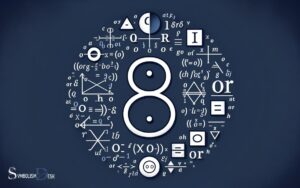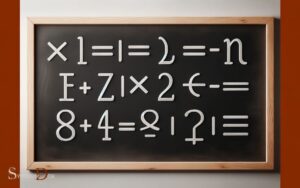How to Write Math Symbols? Explanations!
Accurately writing math symbols is fundamental for effective mathematical communication. Mastery of these symbols enhances precision in conveying mathematical concepts ranging from elementary arithmetic to advanced calculus.
Math symbols serve as the language of mathematics, enabling mathematicians and students alike to write equations and expressions succinctly.
Understanding their correct form and usage is paramount:
Mastering math symbols is key to unlocking the precision and elegance inherent in mathematical language.

Key Takeaway
Comprehensive Guide to Math Symbols and Their Usage
| Symbol | Name | Example | Usage |
|---|---|---|---|
| + | Plus | a + b | Indicates addition |
| − | Minus | a − b | Indicates subtraction |
| × or · | Multiplication | a × b or a · b | Indicates multiplication |
| ÷ or / | Division | a ÷ b or a/b | Indicates division |
| ∫ | Integral | ∫ f(x) dx | Used in calculus to denote the integral of a function |
| Σ | Summation | Σ from n=1 to N aₙ | Used to denote the sum of a sequence |
| lim | Limit | lim(x→a) f(x) | Used to denote the limit of a function as x approaches a |
| x² | Exponentiation | x² | Denotes that x is raised to the power of 2 |
| π | Pi | π | Represents the ratio of the circumference to the diameter of a circle |
| θ | Theta | θ | Commonly used to represent an angle in trigonometry |
| ∞ | Infinity | ∞ | Represents an unbounded quantity |
| ≈ | Approximately equal | x ≈ y | Indicates that x is approximately equal to y |
| ⇒ | Implies | p ⇒ q | Indicates that p implies q |
Importance of Math Symbols
The importance of math symbols lies in their ability to succinctly represent complex mathematical concepts and operations.
Utilizing symbols allows for the efficient communication of ideas, enabling mathematicians, scientists, and students to express intricate equations and relationships in a concise manner.
By using symbols such as +, -, ×, ÷, =, <, >, and others, mathematicians can convey complex mathematical operations and comparisons without the need for lengthy explanations.
This brevity facilitates clearer and more efficient communication within the field of mathematics and its related disciplines.
Understanding the significance of math symbols is fundamental to effectively engaging with mathematical concepts and problem-solving.
Basic Math Symbols
When writing mathematical expressions, it is essential to understand the meanings and applications of basic math symbols. These symbols serve as the building blocks for expressing mathematical concepts and operations. Furthermore, a solid understanding of these symbols is crucial for effectively communicating mathematical ideas and solutions. Whether in equations, algebraic expressions, or geometric shapes, these symbols are indispensable tools for conveying precise mathematical information. For online communication, the use of html math symbols allows for a standardized and universally understood way of presenting mathematical content.
The plus sign (+) indicates addition, the minus sign (-) denotes subtraction, the multiplication sign (×) signifies multiplication, and the division sign (÷) represents division.
The equals sign (=) is used to show that two quantities are equivalent. Parentheses () are used to group terms and indicate the order of operations. The exponent symbol (^) is used to denote raising a number to a power.
Understanding these basic math symbols is crucial for effectively communicating mathematical ideas and problem-solving. Mastery of these symbols forms the foundation for more advanced mathematical concepts and operations.
Advanced Math Symbols
Mastery of these basic math symbols forms the foundation for understanding and utilizing advanced math symbols in mathematical expressions. Advanced math symbols encompass a wide range of notations used in complex mathematical concepts.
These include symbols for set theory such as ∈ for “is an element of” and ∪ for “union,” as well as symbols for calculus like ∫ for integration and ∂ for partial derivative.
Additionally, advanced math symbols are crucial in representing abstract algebraic structures, with symbols such as ⊕ for direct sum and ⊗ for tensor product.
Moreover, in advanced mathematical fields like statistics and probability, symbols such as μ for population mean and σ for standard deviation play a vital role.
Familiarity with these advanced math symbols is essential for effectively communicating and comprehending higher-level mathematical ideas.
Writing Fractions
What techniques are used to accurately and effectively write fractions in mathematical expressions? Writing fractions in mathematical expressions requires a clear and precise approach to ensure accurate representation.
To denote a fraction, the numerator (top number) is written above a horizontal line, known as the vinculum, with the denominator (bottom number) below it.
For example, in the fraction 3/4, 3 is the numerator and 4 is the denominator. It’s important to place the fraction within the context of the overall expression, ensuring proper spacing and alignment.
Additionally, using parentheses can help clarify complex fractions within larger equations. Mastering the art of writing fractions is crucial for conveying mathematical concepts with precision and clarity.
Representing Exponents
In representing exponents, one common method is to use the caret symbol (^) to indicate the exponent.
For negative exponents, the reciprocal of the base is used to represent the value. These methods are fundamental in accurately conveying the power of a number in mathematical expressions.
Using Caret Symbol
The caret symbol (^) is commonly used in mathematics to represent exponents. It is a powerful tool that allows for the concise representation of repeated multiplication. For example, 2^3 represents 2 raised to the power of 3, which equals 8.
The table below further illustrates the usage of the caret symbol in expressing exponents:
| Base | Exponent | Result |
|---|---|---|
| 2 | 3 | 8 |
| 5 | 2 | 25 |
| 10 | 4 | 10000 |
Understanding how to use the caret symbol to represent exponents is fundamental in various mathematical concepts, including algebra and calculus.
Negative Exponents: Reciprocals
Negative exponents indicate the reciprocal of the base raised to the positive exponent. When a number is raised to a negative exponent, it means that the number should be taken as the reciprocal of the same number raised to the positive exponent.
For example, 3^-2 is the same as 1/(3^2), which equals 1/9. This concept is essential in simplifying expressions and understanding the behavior of exponents.
When negative exponents appear in an expression, they can be transformed into positive exponents by moving the base to the denominator or numerator, depending on its original position.
Understanding negative exponents and their relationship to reciprocals is crucial for grasping more advanced mathematical concepts and applications, such as in algebra, calculus, and physics.
Utilizing Greek Letters
Greek letters are frequently employed in mathematical notation to represent various mathematical concepts and entities. When utilized effectively, they can enhance the clarity and conciseness of mathematical expressions.
Here are some key ways in which Greek letters are used in mathematics:
- Constants: Greek letters such as π (pi) and φ (phi) are commonly used to represent important mathematical constants.
- Variables: Greek letters like α (alpha), β (beta), and γ (gamma) are used as variables in mathematical equations and formulas.
- Angles: In geometry and trigonometry, Greek letters such as θ (theta) and φ (phi) are used to represent angles.
- Special Functions: Greek letters are used to denote special functions in mathematics, such as Σ (sigma) for summation and Π (pi) for product notation.
Understanding the role of Greek letters in mathematics is essential for effectively interpreting and expressing mathematical ideas.
Notating Special Symbols
In the realm of mathematical notation, special symbols play a crucial role in representing complex mathematical concepts and operations.
These symbols serve as essential tools for communicating intricate mathematical ideas and relationships. Understanding how to notate special symbols is fundamental for effectively conveying mathematical expressions and equations.
Utilizing Mathematical Notation
Utilizing mathematical notation to notate special symbols is essential for accurately conveying mathematical concepts and equations.
When notating special symbols, it’s important to:
- Use the appropriate symbols for operations like addition (+), subtraction (-), multiplication (×), and division (÷).
- Employ mathematical notation to represent relationships, such as equality (=), inequality (≠), and proportionality (∝).
- Utilize special symbols like (√) for square roots, (∞) for infinity, and (∑) for summation.
- Incorporate Greek letters like α (alpha), β (beta), and π (pi) to denote various mathematical quantities.
Representing Complex Mathematical Symbols
How precisely can complex mathematical symbols be represented through notating special symbols? Representing complex mathematical symbols often requires the use of special notation to convey intricate concepts.
For example, the symbol for infinity (∞) represents a concept that is unbounded or limitless. Similarly, the use of Greek letters such as π (pi) and Σ (sigma) allows for the representation of specific mathematical constants and operations.
Moreover, specialized symbols like ∈ (element of), ∫ (integral), and ≡ (identical to) play crucial roles in expressing complex mathematical relationships.
Notating special symbols is essential for accurately articulating complex mathematical ideas, enabling mathematicians and scientists to communicate and work with these concepts effectively.
Mastery of notating special symbols is integral to comprehending and expressing complex mathematical expressions and formulas.
Tips for Clarity and Accuracy
Tips for achieving clarity and accuracy when writing math symbols are essential for effective communication in mathematical expressions.
To ensure your mathematical writing is clear and accurate, consider the following tips:
- Use consistent notation throughout your work to avoid confusion.
- Clearly define any new symbols or notation you introduce in your writing.
- Pay attention to the placement and size of mathematical symbols for accurate representation.
- Proofread your work carefully to catch any errors or ambiguities in the use of math symbols.
Conclusion
Mastering the art of writing math symbols is crucial for clear and accurate mathematical communication. Whether it’s basic or advanced symbols, fractions, exponents, Greek letters, or special notations, attention to detail is key.
By understanding the importance of each symbol and utilizing them effectively, one can convey complex mathematical concepts with precision and clarity. Achieving proficiency in math symbol writing is essential for any student or professional in the field of mathematics.






